Amazing Cinnamon Chip Scones {Best Basic Scone Recipe}
These cinnamon chip buttermilk scones are tender, buttery and perfect, plus, the base scone recipe can be used for endless scone possibilities!
If you follow me on Instagram, you’ll know why I made these buttermilk scones four times before being willing to post them.
Not that I have anything against blobby, spreading scones (they were terribly delicious), because I don’t, but I wanted a foolproof and pretty recipe to give you, and it took a few tries to get the measurements just right.
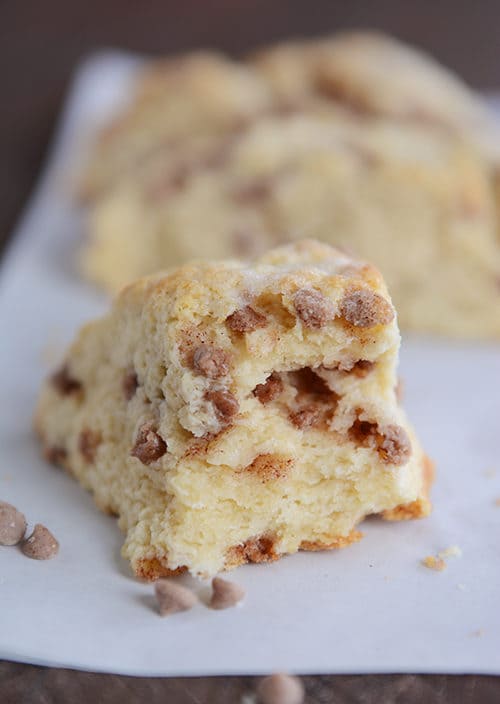
Can we pause for a quick lecture about why a kitchen scale is so tremendously useful in the kitchen?
It truly marks the line between experimental baking and no-fail recipes. I used to think only professional chefs, big baking nerds, or people with too much time on their hands had use for a kitchen scale.
Boy was I wrong.
Several years ago my frustration over inconsistent baking recipes mounted high enough that after screaming in my pillow too many times to count over failed cookies, a kitchen scale ended up in my kitchen, and it’s definitely one of my most prized kitchen tools.
Inexpensive, useful and essential – if you don’t have a kitchen scale, get one! (This is the one I have and highly recommend it.)
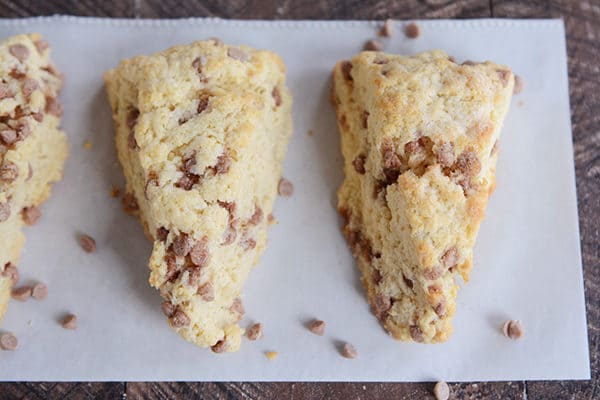
I include weight measures for most of my baking recipes and rarely use a recipe online or in cookbooks that doesn’t include weights, because, call me crazy, I kind of like it when recipes turn out perfectly the first time, don’t you?
If you are morally opposed to using a kitchen scale, please, please, please read this post on how to measure flour accurately.
Ok, phew! Rant over (for now).
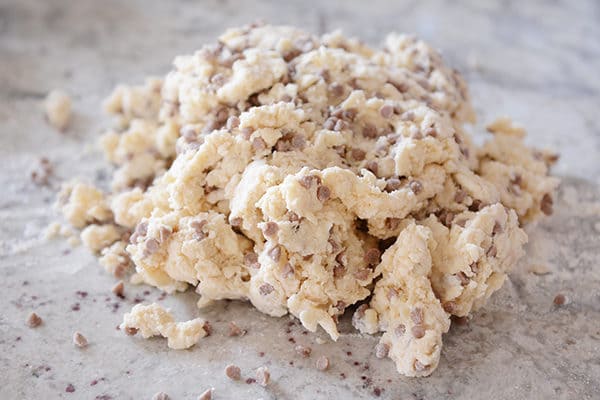
Today’s all-purpose buttermilk scone recipe (that I should be talking about instead of lecturing about scales) is infinitely adaptable.
If you don’t have cinnamon chips, use mini chocolate chips! Or play around with other flavors – maybe lemon or orange zest with an accompanying glaze?
The base buttermilk recipe is so fantastic, it deserves to be put to work.
But I will say that the cinnamon version is absolutely magical. The little cinnamon morsels soften just a bit while baking, leaving behind pockets of sweet, cinnamon flavor with every bite.
King Arthur Flour used to carry cinnamon chips but no longer do (although their cinnamon bits might work just as well). You can find the small cinnamon chips on Amazon or at Orson Gygi.
I included a few step-by-step photos ; sometimes a quick visual helps, especially if you haven’t made or perfected the almighty scone method. It is similar to a biscuit with the cardinal rule: DON’T OVERWORK THE DOUGH!
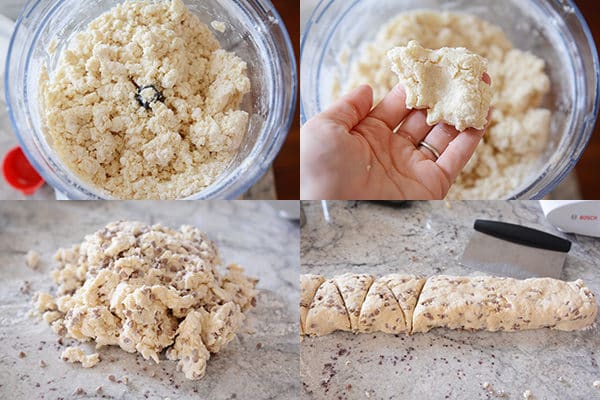
Sorry to shout, but in the interest of avoiding tough, dry scones, it seemed necessary.
Having made these buttermilk scones about a bajillion times over the last month, I can honestly say as a very proud and vocal scone lover that these are some of the best scones I’ve ever had.
I’ll be using this base recipe for just about every scone event from here on out. I’ll also be encouraging my family to strongly think about making these for Mother’s Day; although just between you and me, I’m not above making my own food on Mother’s Day as a means to a very happy end for everyone.
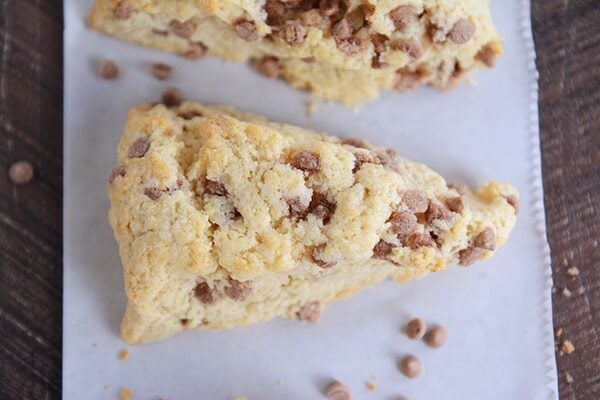
One Year Ago: Mexican Chopped Salad with Simple Honey Vinaigrette
Two Years Ago: Oatmeal Peanut Butter Chocolate Chip Bars
Three Years Ago: Outrageous Eskimo Bars
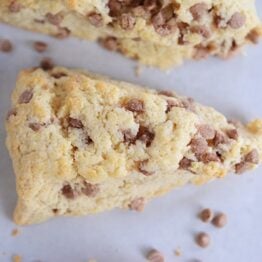
Cinnamon Chip Scones {Best Basic Scone Recipe}
Ingredients
- 3 ½ cups (497 g) all-purpose flour (see note about whole wheat flour)
- ⅓ cup (71 g) sugar
- 2 teaspoons baking powder
- ½ teaspoon baking soda
- ½ teaspoon salt
- ¾ cup (170 g) salted butter, cut into tablespoon-sized chunks
- 1 cup cold buttermilk
- ½ teaspoon vanilla extract
- ¾ cup (128 g) cinnamon chips (see note)
- 2 tablespoons butter, melted
- Granulated sugar for sprinkling
Instructions
- Preheat the oven to 400 degrees F. Line a large, rimmed baking sheet with parchment paper and set aside.
- In a food processor (see note if you don’t have one), combine the flour, sugar, baking powder, baking soda and salt. Pulse to combine. Add the butter and pulse until the butter is cut into smaller pieces – don’t overprocess here; the butter should be no smaller than pea-sized pieces.
- Add the buttermilk and vanilla and pulse a couple of times until the dough starts to come together; don’t overmix – it’s ok if there are dry, crumbly spots here and there. Remove the blade and add the chips, using your hands to knead them in a bit. Turn the dough out onto a surface dusted with 1-2 tablespoons flour and combine the dough and chips together with your hands, kneading briefly, just 2-3 times, until it comes together. Pat and lightly press the dough into a long rectangle, about 15X3-inches.
- Cut the length of dough into triangular wedges, about 12-14 and place on the baking sheet, about an inch apart. Brush the tops with melted butter and sprinkle with sugar.
- Bake at 400 degrees for 15 minutes until just lightly golden brown and no longer doughy in the center.
Notes
Recommended Products
Recipe Source: adapted slightly from a recipe a faithful reader, Emily B, sent me by way of Taste of Home

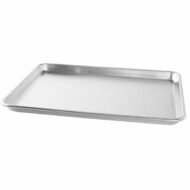
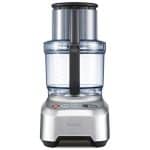
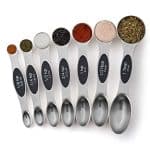
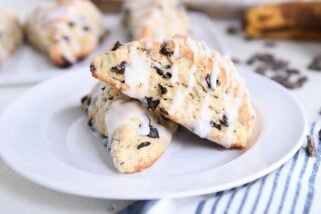
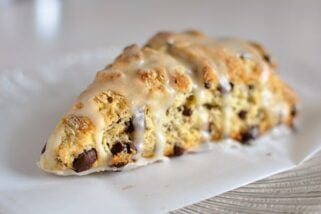
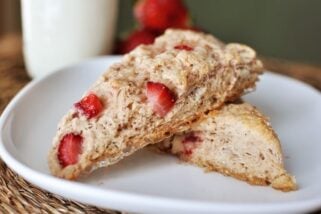
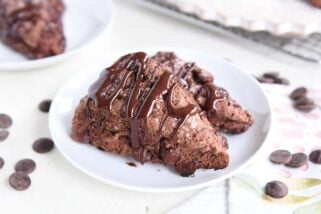
I’m going to give this a try! I’ve felled so many times before. But refuse to give up! Will let you know how I do!
Our favorite scone recipe ever!!!!! As long as you follow the directions, they will be perfect every time!
what was i suppose to do with the 2tbs melted butter?
In step #4 it indicates to brush the tops of the scones with the melted butter.
Made these a few days ahead of Easter. I should have doubled the recipe- they may not make it to Easter Sunday. So good! Other recipes omitted the buttermilk or added powdered cinnamon- not necessary, these were perfect,
WOW! These were delicious.
Wow! Made these for a women’s tea at church. Could NOT find cinnamon chips the week of Christmas in Pittsburgh anywhere! So I made my own! Easy to make and they worked really well! https://www.brighteyedbaker.com/diy-cinnamon-chips/
Wow! You are amazing!!
I was really nervous as I had never made scones before. No more! I have made two batches of these in the last two weeks, and they are scrumptious! Today, I used the basic recipe but instead of cinnamon chips, I added grated orange peel, dried cranberries, and small pieces of Ghirardelli white chocolate bar. Incredibly delicious!
Thanks, Mel!
Hello, I made these scones last night for work today. I did not alter any of the ingredients and made them exactly as the recipe indicated. These scones were amazing. Usually my scones are gone by late morning, today the container was empty after one hour. Thank you immensely for sharing this recipe they were a hit!
Love these scones! I’ve made them a few times and they’re easy to make. Also gives me an excuse to use my food processor. 🙂
this really is the best scone recipe! i’ve tried many others from other websites/blogs and they don’t compare. super easy to make, using the food processor. they have a lovely tender crumb and i love the sugary, crunchy topping (we used turbinado sugar). yum!!!
My favorite scone recipe for blueberry scones…well who am I kidding….for all my scone variations!! Lol thank you.
These are absolutely delicious. I’ve made them 3 times in 2 weeks with rave reviews!! So easy in the food processor. I tried it with huckleberries the 3rd time and made a huckleberry glaze for the top (powdered sugar, butter, cream, and mashed huckleberries) and they were “next level”. Thank you so much for another delicious winner!
I have been meaning to try these for for years, and finally ordered some cinnamon chips on Amazon. They are INCREDIBLE! My whole family loves them. I wish I would have started making them years ago :). I used the Hershey’s brand mini cinnamon chips and I think they’re great – but I’ll try the ones you suggested next time.
The KAF cinnamon chips were the best and I was a loyal buyer, but they discontinued them a long time ago. What do you use now? The Hershey ones were disgusting.
Hi Ashley, I’ve used both the Prepared Pantry ones (https://www.preparedpantry.com/products/cinnamon-chips-11-oz?_pos=2&_sid=b2579d4f2&_ss=r) and the ones they sell at Orson Gygi (https://www.gygi.com/Cinnamon-Baking-Chips-2-Lb.-Bag) both are delicious!
Can you correct the link in the recipe? I thought I was buying the KAF cinnamon chips but it was a link for “cinnamon bits” and I didn’t notice.
Yes, will do. The cinnamon bits will likely work really well in this recipe, too.
These were outstanding. I would totally make these again. These tasted like the cinnamon scones Starbucks used to make years and years ago but so much better!
Thank you so much for this recipe! It turned out perfectly. I don’t have a large enough food processor, so I used my stand mixer with the paddle attachment. I added the super cold butter in cube by cube and then added the buttermilk slowly to the dry mixture. It came together flawlessly. The only thing I may change when I make these again is using unsalted butter instead to cut back on the saltiness. (My preference) Family approved!! Thanks
Mel – would it work to sub 1/2 cup sour cream plus 1/2 cup of whole milk for the buttermilk? I seem to recall that you do a sub like that in one of your bread or muffin recipes and it worked fine….? Or maybe I’m wrong
Yes, that would work great! I use that sub all the time for buttermilk.
I’m so excited to give these a try! Then after I try the cinnamon version I’m dying to try a white chocolate raspberry version. I had a neighbor a long time ago that made them and I’ve been wanting a copy cat version for years! Here’s to experimenting in the kitchen!
Simply the best! Thank you for another outstanding recipe!
Cannot get cinnamon chips in Canada! Why not?
I have no clue but I made these with homemade cinnamon chips and they were next level. Google it. Super easy to make and so much better.
This recipe is incredible. These scones have become the most requested thing I bring to events or give as a gift.
If you were to make these with sourdough discard, would you do 1 cup discard, 3 cups flour, and 1/2 cup buttermilk?
Yes, that’s exactly what I’d do! And then I’d add a bit more buttermilk if needed (if the dough is dry)
I love these! They are my go-to scone recipe. Finding cinnamon chips is the issue. I have just ordered from Amazon – so I have them on hand. Not too sweet, light and fluffy. Thank you!
Love these scones. On Pintrest, I found a wonderful cinnamon chip recipe. “A Few Shortcuts.com” Homemade Cinnamon Chips. Super easy
I need a lot long to bake these 24 min. Am I doing something wrong? I’ve checked my oven temp and that is fine.
Hi Kristin – it could be the size of the scones. How many are you getting out of the batch? Also, are you using convection bake or standard bake?
This is my go to scone recipe. I love that there are no eggs in this version so family that have egg allergy can enjoy them. They are very easy, perfect texture and easy to change out the chips for something else. Thank you so much for sharing!
I made these scones for the first time today and you have a wonderful recipe! I am lactose intolerant so I made some changes with great results. I used ghee (clarified butter) instead of butter. I didn’t have any buttermilk on hand so I made buttermilk using lactose free milk and lemon juice. The scones were light, fluffy and delicious-my family loved them!
Thank you for this modification! We have a dairy free home and I was wondering if this would work!!
This is my go-to recipe for buttermilk cinnamon chip scones. They are delicious and flaky. Nice and light. Anyone I make them for raves about them. Thank you!
Hello! Can you make the dough ahead of time (like the day before) and then bake fresh?
Yes, you definitely can!
Saw that Target was carrying cinnamon chips so I just had to find a recipe for copycat Trader Joe’s cinnamon chip scones. These were SO good. Will definitely become a family staple.
I want to make these as plain scones to serve with lemon curd… I don’t have buttermilk but I had bought whipping cream … can I sub out the whipping cream for the buttermilk in this recipe? Thanks for your help, Mel!
Hi Laura, if you try that, I think I’dd add a tablespoon of lemon juice with the whipping cream for the missing acidity
Hi Mel, can you tell us what brand of cinnamon chips you use. Do you order them from a site. I have not been able to find them in mini chips. Thanks.
Hi Laurie, I buy them from King Arthur Flour or Prepared Pantry (both are available online).
I have made this Exact. Same. Recipe (except no vanilla) over 100 times in the past 5 years (from Taste of Home magazine). It’s my go-to for brunches, work potlucks, and just breakfast for no special reason. More people ask me for this recipe than any other! The hardest part is finding the mini cinnamon chips. I’ve tried it with regular sized chips (like a typical chocolate chip) and it’s not good at all! They don’t melt the same and the cinnamon flavor is too intense. Gotta use the mini cinnamon chips. So if/when you find them, buy them all!!
The Best Scone Recipe!!!! I’m always trying to find the “Perfect” recipe for chocolate cake, white cake and Scones. I’ve made this recipes several times in last 2 years & it’s always delicious. This week for some reason I wanted to find the Perfect scone recipe so I tried Three new recipes from different sites . They were pretty good. Today I decided to make this Cinnamon Chip Scone again to see how it compared to the others I’d just made. Hands Down This IS The Best Scone Recipe !!!!!!! I forgot how tender & flaky these scones are. I’m throwing my other scone recipes away. This is the only recipe I need. Thank You !!!!! So good you can serve as dessert